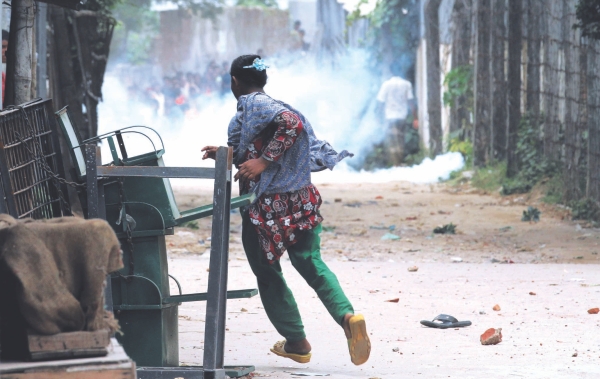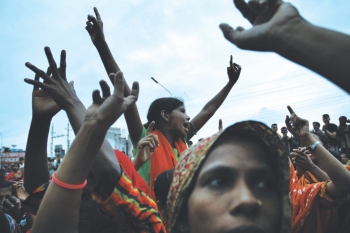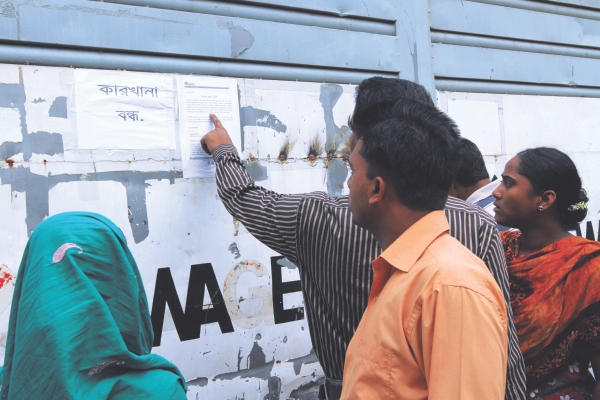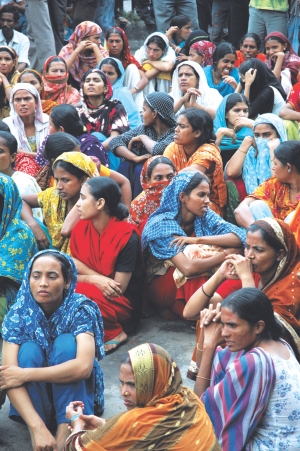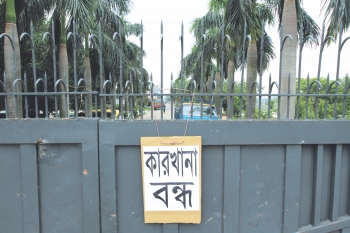| Home - Back Issues - The Team - Contact Us |
 |
| Volume 11 |Issue 26| June 29, 2012 | |
|
|
Special Feature In the Race to the Bottom With some of the lowest wages and worst working conditions in the world,
Bangladesh's garments workers are on the verge of an uprising. In the country's
race to the bottom, have we ignored the human costs of economic growth? Sushmita S Preetha
This was a movement against hunger,” says Tonni, a 22-year-old garments worker who left her village in Noakhali two years ago to make a life for herself. She says she is no activist, and has never been involved in protest-related activities prior to this. “I found myself on the streets of Ashulia because I was desperate,” she explains. She is hopeful that something positive will come out of the week-long struggle. Her roommate, Salma, however, is sceptical. Having worked in Ashulia for more than eight years now, she has reasons to believe that nothing substantial will occur, and that her life will remain the same as before. After all, it is not the first time that Salma has witnessed a major unrest over demands for wage increases. She vividly remembers the protests of 2010, when workers demanded higher wages and better working conditions. After months of intense negotiations and labour protests all over the country, the Labour Ministry finalised a new wage framework, setting the minimum wage at Tk 3,000. The labour organisers and leaders in her area weren't happy, she recalls – they thought the minimum wage set was too low to cover the basic living costs of a family. However, for Salma, who used to get paid less than Tk 2,000, the new wage structure seemed like a dream come true.
But the sharp rise in the cost of living and countless rent hikes over the past two years has left her pretty much in the same position as before – living from hand to mouth. The current minimum wage of $38 per month (adjusted at the current exchange rate) is the lowest in the world. It's no big secret that the cheap labour of people like Salma and Tonni is what attracts foreign investors to the country and makes our garments exports competitive around the world. The state, meanwhile, turns a blind eye towards the inhumane work conditions and negligible pay of the nation's most valuable resource – all for the sake of economic growth – or so we're told. As a result, these workers are at the very end of the “race to the bottom” in terms of wages, benefits and job security. According to workers in Badhail area in Ashulia, their monthly income is insufficient to maintain a satisfactory lifestyle. “You'll know how we are living if you just take a look at our haaris (pots). If you find fish in any of the kitchens, you'll know he or she is well-off,” says Shoroj, a 31-year-old junior operator. “For the rest of us, even eating plain rice and daal three times a day is becoming a difficulty,” he adds. Shoroj gives a rough estimate of the living expenses in the area: rent – Tk 1,300, vegetables – Tk 1,000, rice (20 kg) – Tk 600, fish (twice a month) – Tk 200, necessities like soap, oil etc – Tk 300, clothing – Tk. 300, medical – Tk 300, pocket spending (for tea, cigarettes etc) – Tk 400, transport – Tk 400. They add up to Tk 4,200, an amount that far exceeds the minimum wage in the industry. The monthly household expenditure for a family of four is higher still. Even though workers are supposed to work an eight-hour shift, in accordance with Bangladesh's labour law, most work overtime to earn a few extra taka. Moreover, many garments workers have to put in unpaid overtime in order to meet unrealistic production targets set by factory owners. “Since the new salary structure was established, the production targets have increased from say, 200 units to 230 units. Now we have to do what we did in 10 hours within 8 hours, and if we fail, we must work the additional hours without extra pay,” says 26-year-old Ruma. Most employers deny such allegations, claiming that the production targets are more than achievable in an eight-hour shift if the workers are productive. However, according to extensive research conducted by the War on Want, an international organisation committed to global justice, 64 percent of the women workers interviewed stated that targets were unrealistic within the legal working time, while 75 percent of workers interviewed said they failed to meet their targets within the time allotted. The research also indicates that garments owners cut overtime pay whenever they can – for lack of punctuality, failure to meet production targets, unnecessary conversations with co-workers, absence without leave, making mistakes at work or protesting management decisions etc. The workers of some factories argue that they no longer get an opportunity to work overtime, which makes it even harder for them to sustain themselves. Others, however, especially women, report working as much as 100-140 hours of overtime every month. “I have two children and my husband is unemployed. If I want to feed all of them and send my children to school, I have to work as many hours as is physically possible,” says Rehana. “I wake up at 4 am to stand in line for the shower, and start work at 8 am. I usually work till 11 pm. It's midnight by the time I reach home,” she adds. Her children are asleep by the time she returns home and she must clean and cook for the next day before she can go to sleep. Rehana shares that many of her colleagues are forced to work night shifts, and are threatened with losing their jobs if they dare to refuse.
The workers highlight that there are no platforms where they can present their concerns and problems without fear of repercussions. “The Sramik Kolyan Committees, which are supposed to address our demands, are run by people who are close to the owner, or the General Manager or Production Manager. They exist only by name. There is no one to speak on behalf of the workers,” opines Mokhles (not his real name), a local labour organiser. The workers state that as soon as someone is vocal about the injustices or exploitation within a factory, s/he is fired, if not harassed and assaulted. Mokhles was the chairman of the Worker's Association in a Chinese factory, where he was very vocal about worker's legal rights. “Legally, we are entitled to 18-days leave a year, and if we work on those days, we are supposed to get paid overtime, which we never did,” explains Mokhles. “First, the managers tried to terminate us, and when we refused saying you can't legally terminate members of the Worker's Association, they filed false cases against us,” he adds. In the absence of trade unions, or collective bargaining power, frustrated workers are often forced to take desperate measures to get their voices heard. As Rehana argues, “The reason we take to the streets is because, say for example, we want to ask for higher wages within the factory. Obviously not everyone will talk to the Management and not everyone will have the courage to face them. So if 50 of them talk, they will fire those 50. Then the rest of them will be afraid to speak. That is the sole reason that the movement comes out on the streets. People are afraid to talk.” When the workers of one factory come out into the streets, workers of other factories are motivated to do the same. They know that as long as they walk out together, they will not be fired. Even then, many people, especially women, are afraid to be seen agitating in public. “The women of our country are not yet conscious of their rights or of the worker's movement. But still, they do come out and show their support. For instance, this time, there were a lot of women on the forefront of the struggle; they are integral to the movement,” says Rizvi Shorkar (not his real name), another left-leaning labour organiser. The factory owners and the state point to unspecified “outside forces” as reason for the recent “unrests” – as they have over the years to justify why workers protest so stridently. “They have been saying the same thing since the beginning of the worker's movement. It is clear that the people and the media who claim that it's a conspiracy are unwilling to acknowledge the plight and sacrifices of the workers,” argues Morshefa Mishu, prominent labour leader and president of the Garments Workers Unity Forum (GWUF). According to labour organisers and analysts, stories of unspecified dark forces, which incidentally have never been proved, are used for a variety of reasons – to rationalise the status quo, to convince foreign buyers that unsatisfactory working conditions in many facories are not responsible for the unrest, to ensure foreign NGOs stop portraying an embarrassing image of Bangladesh to the world and so on. Mishu believes that if the state and the factory owners really want to bring peace to the troubled lands of Ashulia, they must stop using 'the forces of outside evil' as an excuse for the unrests. “If they don't pay attention to the demands of the workers, things will only deteriorate,” warns Mishu. There are complex reasons that drive workers to take to the streets. While there be some truth to accusations of local corrupt forces at play in Ashulia, to dismiss the series of demonstrations that have occurred in the region as invalid would be short-sighted on the part of both garments owners and the government. Despite promises, the owners have not as yet discussed the worker's demands with the workforce and given them any concessions. The government maintains that it will give ration cards and implement positive changes for the garments workers, but the proposed changes, even if put in action, may not address the concerns of the workers unless they are included in the decision-making process. Most labour leaders and workers believe that allowing them to form trade unions – platforms for representing worker's interests – is a prerequisite to a vigorous and functioning garments industry. Unless we can ensure that their voices are heard, unrests, like the one we saw in Ashulia, are inevitable. As Tonni says, “Just see the conditions under which we work and survive, and then you'll know why we protest.”
Garments: On the Brink? The garments in Bangladesh have played a decisive role in the
country's economy. However, recent events suggest that the
country's leading industry might be floating on dangerous waters. Naimul Karim The latest spate of violence in Ashulia's garments industry was met with a different approach by factory owners. As a result of the hostility, the Bangladesh Garments Manufacturers and Exporters Association (BGMEA) closed down more than 300 factories in the region, for four days, this month. Apart from being questioned by the high court, the new strategy also proved to be expensive for the owners, as they claim to have suffered huge losses. Despite the controversy surrounding the issue, factory owners stand by their decision of temporarily shutting down their units. "Various people were vandalising buses and factories in the area. How can somebody possibly feel secure amidst the violence? Several owners came to me and told me that they wanted to shut down their factories. Being their representative, I complied with their decision," explains Shaiful Islam Mohiuddin, president, BGMEA, "The labour department in the government wasn't taking any step to control the situation and we therefore, had to close down."
Echoing Mohiuddin's views, Abdus Salam Murshedy, President of Exporters Association of Bangladesh, claims that the owners were compelled to lock their factories. "The protests began on June 11 by the workers under the Hamim Group. There were a few internal problems which later on spread throughout Ashulia," says Murshedy. Murshedy claims that the owners tried every possible step to avoid the closure of their units. "The workers would enter the factories, punch their cards, thereby signing their attendance and leave without doing any work. Signing the card meant that we'd have to pay them. We sat with government agencies and tried to solve the problem, but nothing happened. It was then that the company owners decided to pull the plug," he explains. Speaking to the Star, several workers from Ashulia stated that their main demand was to receive better wages. Many claim to have been suffering due to the burdensome increase in their house-rent and the cost of various other basic necessities. Accepting these problems, Mohiuddin says, "Our workers may not have problems regarding food, but there are other troubles. The house owners, in the region, increase the rent three to four times a year, which proves to be a huge burden for the workers. Concerned officials from the government need to be vigilant in this regard." Sharing Mohiud-din's views, Md Fazlul Haque, former president of Bangladesh Knitwear Manufacturers and Exporters Association (BKMEA), says," The workers have frequently raised the rent issue. It's valid on their behalf. But honestly speaking, the rent spiral is not in our hands. We don't have any right to control prices set by the house owners." With regard to workers' wages he says," The pay structure has always been a problem, but you can't just change it immediately. They are getting periodical increments. It's not an easy job to change the national pay structure." Responding to the workers' demand, Mohiuddin claims that the factory owners are ready to address any such requirements as long as it's done in a peaceful manner. "You won't get any results by torching buses and vandalising factories," he says. The series of agitations in Ashulia, in the last couple of years, have made it a hotspot for the garment workers to place their demands. However, the question remains as to why the industrial region, which constitutes more than 20 percent of the country's garment-exports, has repeatedly been witness to such protests. Analysts have come up with several theories behind the frequent unrests in Ashulia and the absence of a proper labour union in the region is one of them. "The trade unions in Ashulia are politicised. They are corrupt and mostly do not represent the workers," claims Mohammed Quasem, Director, Echotex ltd. Quasem, whose company in Shafikur was recently given the 'best international supplier' award by Sainsbury's Uk Ltd, believes that Ashulia should build a strong labour department in order to raise the workers' concerns peacefully. Stating his own company's example, he says, "In our case, instead of naming the groups as trade unions we call them the 'Workers' Participatory Committee.' We encourage our employees to directly tell us their problems, after which we respond to them." Certain owners are of the opinion that the frequent agitations might be a conspiracy organised by a foreign group in order to destabilise the country's most dependable sector. "There may be international groups involved in this. You never know. Vested quarters may want us to go down," says Mohiuddin, adding that the government has formed a team to find out the 'official reasons' behind the agitation. Fazlul Haque on the other hand, dismisses the possibility of the presence of a 'foreign group' and blames the local politicians for the chaotic situation. "I don't think there is a foreign hand in this, but if things continue the way they are going right now, then certain vested groups may take advantage of this situation," he claims.
With international markets on the brink of a recession, the frequent unrests in the garments sector add to the woes of the export industry. Reports from the Exporters Association of Bangladesh state that the export growth in the garments sector was only 6 percent in the last three months. An abysmal statistic compared to last year, when the industry grew by almost 50 % during the same time. “The June-July phase is the period when we start negotiating with our buyers for the next season. These unrests can definitely have a bad impression on them,” says Murshedy. Industry owners feel that the garments sector is currently at a crossroads and need the government's support in order to survive. “The industry will fall soon if such practices continue. It's a very sensitive business. Orders tend to disappear with the slightest of increments in prices. We don't have an alternative industry to depend upon as yet, so we need to hold on to this,” says Quasem, adding that the companies that do not follow the national wage structure should be brought to task by the government. The closing down of more than 300 factories, albeit for a short period of time, is a warning that the government should heed to. The industrial region in Ashulia contains lakhs of workers and is perhaps the heart of the country's garments sector. As Mohiuddin puts it, “It might be the local politicians, might be a foreign group or it even might be corrupt factory owners. Whatever the reason behind the unrests may be, the garments industry is a national asset and we need a solution to preserve it.” Whether the committee, recently formed by the government, can actually manage to address the vital problems in the region is a question that lingers. The answer to which will perhaps decide the future of the garments in this country.
|
||||||||||||||||
Copyright
(R) thedailystar.net 2012 |
